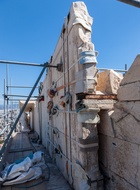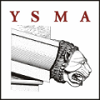In the presence of the General Secretary of Ministry of Culture Dr. Maria Andreadaki-Blazaki and the President of the Committee for the Conservation of the Acropolis Monuments (ESMA), academic M. Korres, the central orthostate of the tympanum of the Parthenon’s west pediment was dismantled (Thursday, June 22nd). Apart from the central orthostate, other blocks of the west pediment present serious breakages due to the corrosion of the iron clamps (which clamps were placed during the pre-war era); due to this reason, the intervention at the area was considered of high priority. The programmed intervention, apart from the dismantling of three blocks of the orthostate, includes the dismantling of five blocks of the wall behind the tympanum. Interventions of the restoration of old mortars and iron clamps, as well as systematic conservation, which are needed in all adjoining blocks, will be done in situ. The works are estimated to last for the duration of two years. The interventions at the west pediment are included in the project ‘Conservation and Restoration of the Monuments of the Acropolis,’ that was recently incorporated into the Operational Programme Competitiveness, Entrepreneurship and Innovation 2014-2020 (EPAnEK) of the NSRF, with a budget of 5.000.000€.
Apart from the west pediment, interventions of restoration will be carried out in the north wall of the Parthenon Cela. Also, the formation of the column flutes on the supplements of the columns of the Pronaos and the restoration and the reposition of the beams of the roof of the west wing of the monument.
The interventions at the Circuit Wall will begin at the area of the north side (adjacent to the Propylaia) where scaffolding has already been placed and will continue on the north side of the Erechteion. Interventions of a smaller scale are predicted to take place at the area of the south side of the Wall, near to the SE corner of the rock.
Alongside the restoration works, interventions of conservations will take place not only at the Parthenon and the Wall but at the Propylaia and areas that have not been recently conserved as well. Apart from the restoration and the conservation of the monuments included in the programme until the end of 2020, many other operations for the rescue and accentuation of scattered architectural members are about to take place; the geometric documentation of the monuments, the documentation of the works; the display of the project through digital applications, educational programmes, etc.

[print-me target=".entry-title, .breadcrumbs, .entry-content" do_not_print=""]







